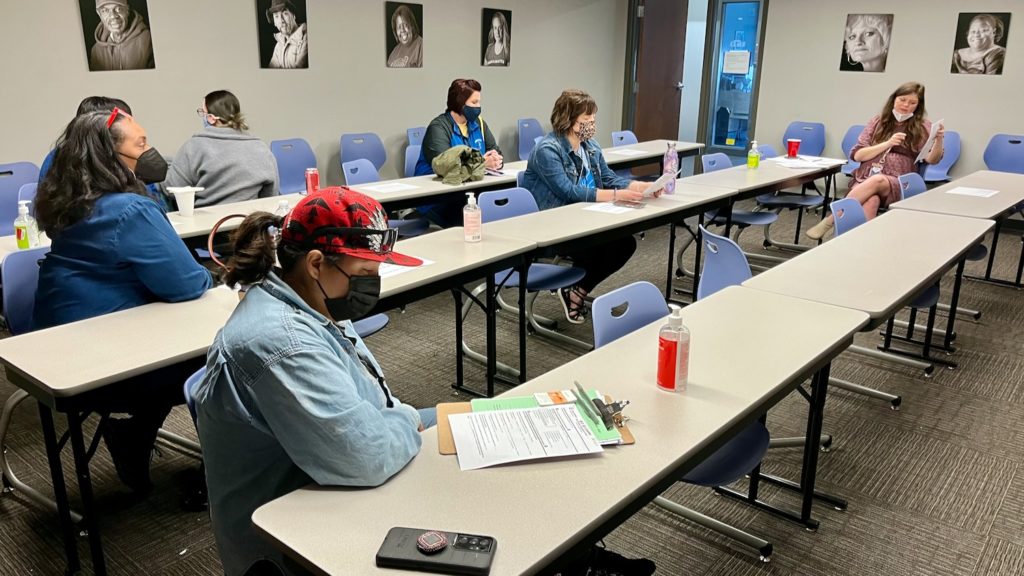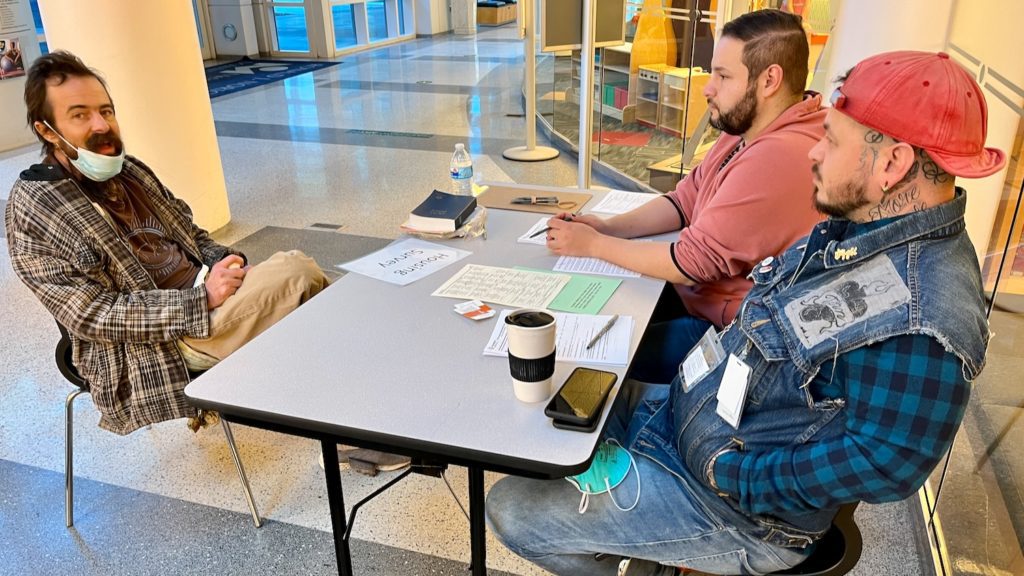Last Updated on March 6, 2022, 8:51 AM | Published: March 4, 2022
OKLAHOMA CITY (Free Press) — Once again, volunteers fanned out across Oklahoma City to count the city’s homeless Thursday. And, once again, the largest effort was first, to find them.
While some casual observers become distressed at the visible camps around the metro, the people who live outdoors that are obvious make up only a portion of the city’s people without homes.
It was a return to what had been an annual practice before the pandemic created a major interruption early in 2021. (The 2020 count was accomplished at the end of January 2020 just before lockdown.) Volunteers and agency staff collect data that helps the City of Oklahoma City and various aid organizations to apply for grants from the federal Housing and Urban Development (HUD) program for reduction of homelessness.
Starting at 3:00 a.m. volunteers gathered at the Westtown campus of the Oklahoma City Homeless Alliance to organize into teams that would first begin finding camps early in the morning before those living there start moving around for the day. Possible locations were spotted ahead of time by social workers in various agencies and by the Homeless Outreach Team of the Oklahoma City Police Department.
But, as the day progressed, other volunteers started working the less obvious but no-less important places that the homeless frequent such as the public libraries.
“Public space”
In years past, Free Press has gone out with teams to the camps and reported the counting with those in them.
Thursday, we sat in on training for those volunteers who were going out into the public libraries for the day to gain a count of those who may be the less-obvious homeless. Then, we went with the team assigned to the Downtown Library of the Metropolitan Library System (MLS).
As soon as the doors opened, some who had been sleeping nearby started to filter in.
Unlike the teams that actively went out to the camps and other places of shelter to seek out people to interview, those assigned to the libraries were not allowed to approach anyone. MLS staff were concerned that those who depend on library resources would react negatively in a space that is supposed to be welcoming.
That fundamental respect for those who choose to enter a library is at the core of the MLS. We talked to Kimberly Boldt, director of outreach and engagement about that dynamic, especially with those who are experiencing homelessness.
“So, the libraries are like the last bastion of a free space,” said Boldt. “We are the great equalizer, the place where everybody’s welcome, and it’s one of the last places where you don’t have to buy anything.”
She continued, “You don’t have to buy anything. You can stay here from the minute we open till the minute we close as long as you’re abiding by our rules of conduct, which are reasonable.”
MLS provides a number of human and technological resources that are critical for anyone who is attempting to stay connected and make a shift in their lives whether it is applying for a job, or applying for housing assistance, or any number of other things that many of us consider to be routine because of our connected households or workspaces.
We asked Boldt about the most-used resources that the homeless often use.
“Probably one of the biggest is technology, the internet,” she said. “A lot of people get the free government phones but they need Wi-Fi. We have a great Wi-Fi network here. Our IT team is great at getting things working and any solving any problems.”
But, anyone can ask their staff for help navigating the Internet to find resources and to get help just figuring out where to look in the first place.
“A lot of people come because they don’t know where to start,” said Boldt.
Gathering data
Andrew Dallaly and Jason Hall, both social workers, were the team assigned to the Downtown Library. They told me that most of their contacts right after the doors opened were people who were needing help in finding resources.
“On normal work days we are talking to people about resources,” said Dallaly. “Today, though, we’re trying to stay in survey mode because once we get into a resource sharing mode, then that could take the whole time.”
Their table was set up where anyone who waked into the main door of the location would see them and some were stopping mostly out of curiosity.
But, still, many just wanted some sort of interaction or help and ended up answering some survey questions.
Unexpected places
At the training for the library count volunteers, those libraries where MLS had notified the Homeless Alliance of possible homeless populations signaled that just the downtown area is not the only place in the city where the homeless are living.
Some sleep on a couch of a friend or family member. Some sleep in their cars. And, some find secluded places to camp outdoors out of public view to keep from alarming neighbors.

Southern Oaks on the southside, Ralph Ellison on the eastside, and Northwest near NW 122 and MacArthur were among those branches where volunteers were being sent because of tips the Homeless Alliance had received from staff at those locations.
Those locations might come as a surprise to those who have the idea that homelessness is an issue that only affects the core of the city.
“Edmond [branch] actually also responded and wanted us but this is the Oklahoma City Point in Time Count,” said Meghan Mueller, associate executive director of the Homeless Alliance. She conducted the training for the library volunteers.
The idea that staff in the Edmond branch in downtown Edmond have been seeing enough people they suspect of being homeless to ask for volunteers in the count may come as a shock to some whose view of Edmond matches up with the carefully-crafted one realtors have promoted over the last 50 years.
City, Homeless Alliance collaboration
The Homeless Alliance works closely with staff in the City of Oklahoma City to bring as many resources to the homeless population as possible.
“It [point in time count] is so vitally important because it helps us navigate the resources and pinpoint them in the right direction,” said Jay Bridwell told Free Press. He is the director of support services at the Westtown campus. “We want to make sure that we’re doing the things that are going to have the most impact and the most to the for the folks that need the most.”
The money that supports the Homeless Alliance comes from charitable donations from large foundations and individual donors. It also comes from HUD grants that are applied for by the City of Oklahoma City. The City uses some of those funds for their own projects to alleviate the City’s affordable housing shortage, and it also channels some of those grants to organizations like the Homeless Alliance.

Jerod Shadid, the City’s program planner for homelessness services, talked with Free Press later in the morning of the count.
He said that HUD requires a point in time count every two years in their grants but the City and the Homeless Alliance do it every year to keep closer track of the populations they serve.
“We break it out into subpopulations and that allows us to also figure out where those problems are with particular subpopulations,” Shadid told us.

He said that this year they added more questions to their street survey “to get a better grasp on some issues,” especially in terms of just how that populations might have changed over two years. The last point in time count was at the end of January 2020 only a month before COVID hit Oklahoma City.
“Most cities have seen an increase in homelessness over the course of the pandemic,” said Shadid. “We don’t know if we have yet. But we believe we have because it has become more visible.”
“It’s changed a lot. We just don’t exactly know how, so that’s the importance of doing it this year is to kind of figure out some of the new factors that are creating homelessness and really driving those numbers.”
He said that some program grants from HUD are competitive and some are not. But, all require supporting numbers to show the City what to apply for and to show HUD the need.
Some indicators of nationwide trends are pointing to the possibility that cities especially could find that starting with the beginning of the pandemic and up to next year, cities could see a 50% increase in homelessness because of the decreasing availability of affordable housing.
Shadid said that the long-term problems that lead to homelessness is development of housing and finding a way for landlords to agree to receive money for housing those persons who need assistance.
Founder, publisher, and editor of Oklahoma City Free Press. Brett continues to contribute reports and photography to this site as he runs the business.











